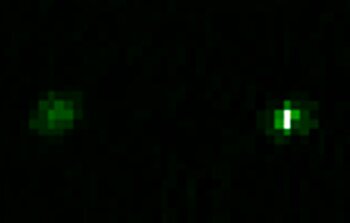Half of all Exoplanet Host Stars are Binaries
September 2, 2014

The following is duplicated from the National Optical Astronomy Observatory press release, distributed on September 3, 2014.
Imagine living on an exoplanet with two suns. One, you orbit and the other is a very bright, nearby neighbor looming large in your sky. With this “second sun” in the sky, nightfall might be a rare event, perhaps only coming seasonally to your planet. A new study suggests that this could be far more common than we realized.
The NASA Kepler Space Telescope has confirmed about 1000 exoplanets, as well as thousands more stars considered “Kepler objects of interest”, dubbed KOIs – stars that could possibly host planets. Until now, there has been an unanswered question about exoplanet host stars; how many host stars are binaries? Binary stars have long been known to be commonplace – about half the stars in the sky are believed to consist of two stars orbiting each other. So, are stars with planets equally likely to have a companion star, or do companion stars affect the formation of planets? A team of astronomers, led by Dr. Elliott Horch, Southern Connecticut State University, have shown that stars with exoplanets are just as likely to have a binary companion: that is, 40% to 50% of the host stars are actually binary stars. As Dr. Horch said, “It’s interesting and exciting that exoplanet systems with stellar companions turn out to be much more common than was believed even just a few years ago.”
Their study makes use of very high spatial resolution observations that were carried out on the WIYN telescope located on Kitt Peak in southern Arizona and the Gemini North telescope located on Mauna Kea in Hawaii.
The technique used by the team is called speckle imaging and consists of obtaining digital images of a small portion of the sky surrounding a star of interest, 15 to 25 times a second. The images are then combined in software using a complex set of algorithms, yielding a final picture of the star with a resolution better that that of the Hubble space telescope.
By using this technique, the team can detect companion stars that are up to 125 times fainter than the target, but only 0.05 arcseconds away. For the majority of the Kepler stars, this means companion stars with a true separation of a few to about 100 times the Sun-Earth distance (termed the astronomical distance, or AU). By noting the occurrence rate of these true binary companion stars, the discoveries can be extended to show that half of the stars that host exoplanets are probably binaries.
Co-author of the study, Dr. Steve B. Howell (NASA Ames Research Center), commented, “An interesting consequence of this finding is that in the half of the exoplanet host stars that are binary we can not, in general, say which star in the system the planet actually orbits.”
Kepler has discovered a number of circumbinary planets, that is, a planet that orbits both stars in very close binary systems. There also exist exoplanets that are known to orbit one of the stars in very wide binary systems. If the two stars are very close to each other and the planet far away, a circumbinary planet will be reminiscent of Tatooine in Star Wars. If instead the exoplanet orbits one of the stars in a very wide pair, the companion star might appear simply as a bright star among others in the night sky. “Somewhere there will be a transition between these two scenarios,” Howell said,” but we are far from knowing where.”
The accompanying figure shows the Kepler field of view, located between two bright stars in the summer triangle, rising over the WIYN telescope in southern Arizona.
In a study like this, it is critical to rule out faint companions that are only in the line of sight with the KOI star. To allow for these possibilities, the team performed a model simulation that relied on known statistical properties of binary star systems and line of sight companions. The results suggest that the large majority of the stellar companions to KOIs are true bound companions, not line of sight stars unconnected with the system.
This work has been accepted for publication in the Astrophysical Journal. The additional authors are Dr. Mark E. Everett, National Optical Astronomy Observatory and Dr. David R. Ciardi, NASA Exoplanet Science Institute, California Institute of Technology.
The WIYN telescope is operated by the WIYN Consortium, which consists of the University of Wisconsin, Indiana University and the National Optical Astronomy Observatory (NOAO). Kitt Peak National Observatory is a division of NOAO, which is operated by the Association of Universities for Research in Astronomy Inc. under a cooperative agreement with the National Science Foundation.

